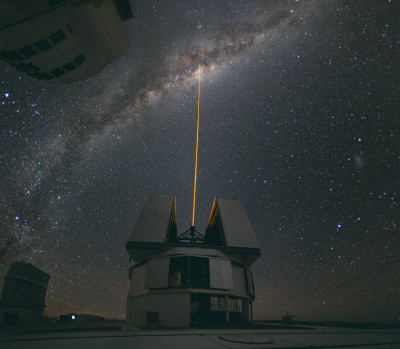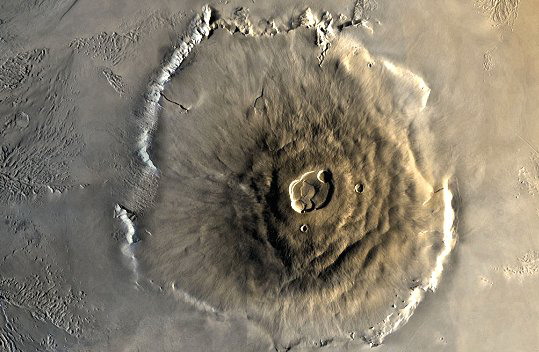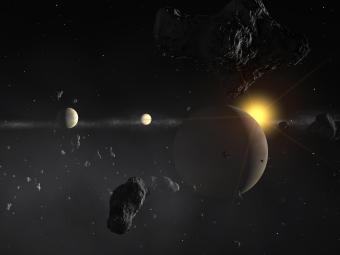
Using the SalsaJ software (download here), students and teachers can make the Universe their laboratory. The hands-on exercises below are designed to allow students to use real astronomical data to find a new planet, explore volcanos on the moons of Jupiter, classify stars, or weigh a galaxy! Each exercise comes complete with real astronomical data and detailed instructions for how to display, analyze, and interpret the data using the SalsaJ software. This software is free, and is multi-platform and multi-lingual (languages supported include English, French, Spanish, Italian, Polish, Greek, Portuguese, Swedish, Northern Sami, Arabic, and Chinese).
At your convenience, a single package containing all the data and files (but not the guides!) needed for the following exercises is available here : euhou_exercises_files.zip - 25.28 Mb.
Simply download the software, choose an exercise and you are ready to explore the Universe!
How to determine astronomical distances using Cepheids?
This exercise enables you to determine the distance from the Sun to the Small Magellanic Cloud by studying a Cepheid and its regular variations of luminosity How to measure the distance to the stars? Or to the galaxies? Brightness is not a direct measurement of distance, because two very different objects, one faint but close, and the other bright but very distant, may look the same on our sky.

One answer to this question was found in 1912 by American astronomer, Henrietta Leavitt, who investigated the Cepheids, giant yellow stars much more massive than the Sun and hundreds or thousands of times more luminous. These stars are actually like lighthouses for astrophysicists: they can indeed be observed from extremely long distances.
Moreover, they all possess a noteworthy distinctive characteristic: their brightness varies periodically, to a very regular rhythm. Studying these variations, she was able to define a relation between this period and the intrinsic brightness of the star, and hence their distance.
In this exercise, we are going to study a series of images from Cepheids in the Small Magellanic Cloud in order to measure its distance from the Solar System.
Read more: How to determine astronomical distances using Cepheids?
From doppler effect to exoplanets
Learn how to find invisible bodies in other solar systems studying the spectral lines of far stars
 In this exercise, we explain how an invisible planet can be unveiled using precise measurement of the velocity of its mother star.
The radial-velocity method uses the fact that a star with a planet will move in its own small orbit in response to the planet's gravity. The goal is to measure variations in the speed with which the star moves toward or away from Earth. The radial velocity can be deduced from the displacement in the parent star's spectral lines due to the Doppler effect, as shown in the upper animation.
In this exercise, we explain how an invisible planet can be unveiled using precise measurement of the velocity of its mother star.
The radial-velocity method uses the fact that a star with a planet will move in its own small orbit in response to the planet's gravity. The goal is to measure variations in the speed with which the star moves toward or away from Earth. The radial velocity can be deduced from the displacement in the parent star's spectral lines due to the Doppler effect, as shown in the upper animation.
A black hole lurked at the center of our Galaxy !?
Tracking the movement of stars around the centre of our Galaxy, the Milky Way, you can unveil the hidden monster: a black hole, four million times more massive than our Sun!
 Black holes are objects whose gravity is so great that nothing - including light - can escape them.
Black Holes can not directly be seen, one can infer its presence by
searching for the gravitational influence it imposes on nearby objects, namely stars.
Observations have been done during almost 20 years, with the most powerful telescopes, including a laser shooting star in a very "star wars" style...
Black holes are objects whose gravity is so great that nothing - including light - can escape them.
Black Holes can not directly be seen, one can infer its presence by
searching for the gravitational influence it imposes on nearby objects, namely stars.
Observations have been done during almost 20 years, with the most powerful telescopes, including a laser shooting star in a very "star wars" style...
This exercise offers, through the analysis of images of the galactic centre, measure the mass of the supermassive black hole. By following the movement of a star, thanks to Kepler's laws, the pupils will get very recent scientific results with a very good approximation. They will come to appreciate the limitations of the method and results.
Read more: A black hole lurked at the center of our Galaxy !?
Volcanos and craters in the Solar System
Scaling the planets
In this activity, images of volcanoes and craters in the Solar system will be examinated using the software SalsaJ. Measurements of the size of craters and ejecta will be possible.

How to weigh a galaxy
Determine the mass of a galaxy and discover dark matter!
This activity measures the mass of a spiral galaxy, viewed edge-on, using the same procedure employed by astronomers. It is surprising how just a few measurements and the knowledge of a few fundamental laws of physics make it possible to weigh the largest and most distant objects in the Universe, despite the impossibility of carrying out direct measurements and the fact that the only information available to us derive from a few photons which have travelled for tens and tens of millions of years. What is even more surprising is the fact that the simple measurement proposed here makes it possible to obtain experimental evidence for the well-known dark matter.

Life cycle of stars - Plotting your own HR diagram!
Measure the true colours of stars and guess the age of the cluster!
 An open cluster (sometimes called a Galactic Cluster) is a group of
10s or 100s of stars that were born from the same initial cloud of gas
(mainly Hydrogen) and dust. When they are young (a few million or tens
of millions of years old), these clusters contain some very large,
bright stars (called O or B-type stars). The very youngest clusters
(usually less than 10 million years old) often still contain the
remains of the gas cloud from which the stars were born – this is seen
as nebulosity.
An open cluster (sometimes called a Galactic Cluster) is a group of
10s or 100s of stars that were born from the same initial cloud of gas
(mainly Hydrogen) and dust. When they are young (a few million or tens
of millions of years old), these clusters contain some very large,
bright stars (called O or B-type stars). The very youngest clusters
(usually less than 10 million years old) often still contain the
remains of the gas cloud from which the stars were born – this is seen
as nebulosity.
Cluster stars are very useful as they were all formed from the same giant cloud (so they have the same chemistry), and they are all at about the same distance from us (although they are typically hundreds or thousands of light years away!). By observing a group of stars in a cluster, we can assume they are all made of the same stuff, and they are all the same distance away from us – so any differences between them are really caused by their different mass.
In this project you will be shown how to use Faulkes Telescope data to measure the intensity of light from the stars in a cluster (a process known as photometry), through different filters, and plot the colours of the stars on a 'colour-magnitude diagram'. Once a measure of how “red” or “blue” the stars are is made, more informtion about them can be obtained– massive stars are usually very blue (hot), intermediate mass stars (like the Sun) are yellow, and the very lowest mass stars are red (cool).Read more: Life cycle of stars - Plotting your own HR diagram!
Discover an exoplanet : the transit method
Unveil an extrasolar planet by observing the light intensity emitted by its mother star
An extrasolar planet, or exoplanet, is a planet outside the Solar System.

Until March 2012, astronomers have made detections of 762 exoplanets (see http://exoplanets.eu for a complete and detailed catalog).
The vast majority of them has been observed through radial velocity and transit observations but other indirect methods also exist : astrometry, microlensing and timing among them.
At present, direct imaging is still difficult, even if lots of progress is being made. Anyway, most of the discoveries are about giant planets, thought to resemble to giant Jupiters, orbiting near to their stars, where they are more easy to detect.
In this activity, we propose to unveil an extra-solar planet using the transit in front of its star. (You can find here an exercise on the detection of exoplanets by the radial velocity method.)

